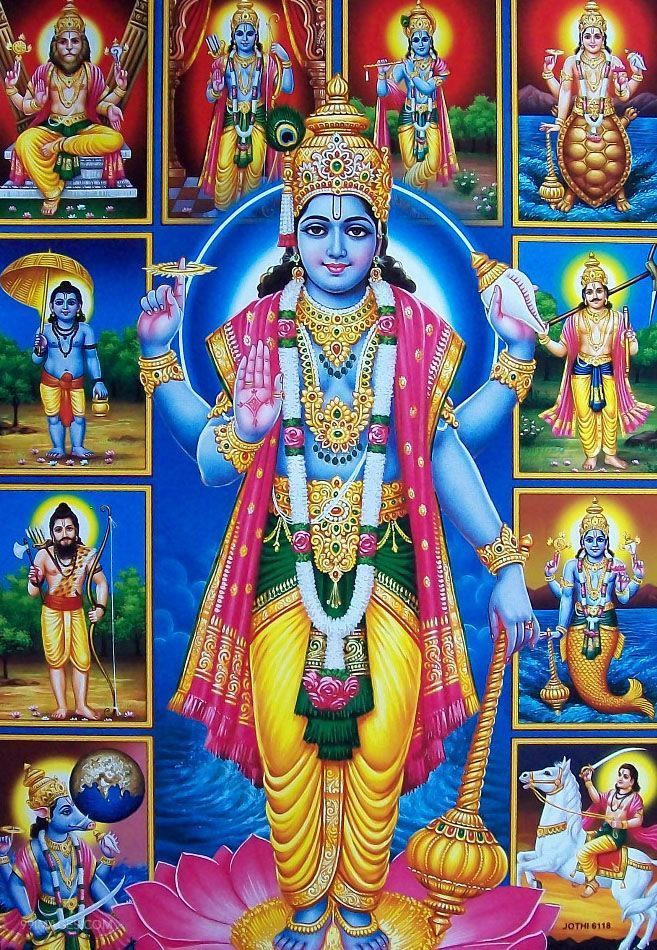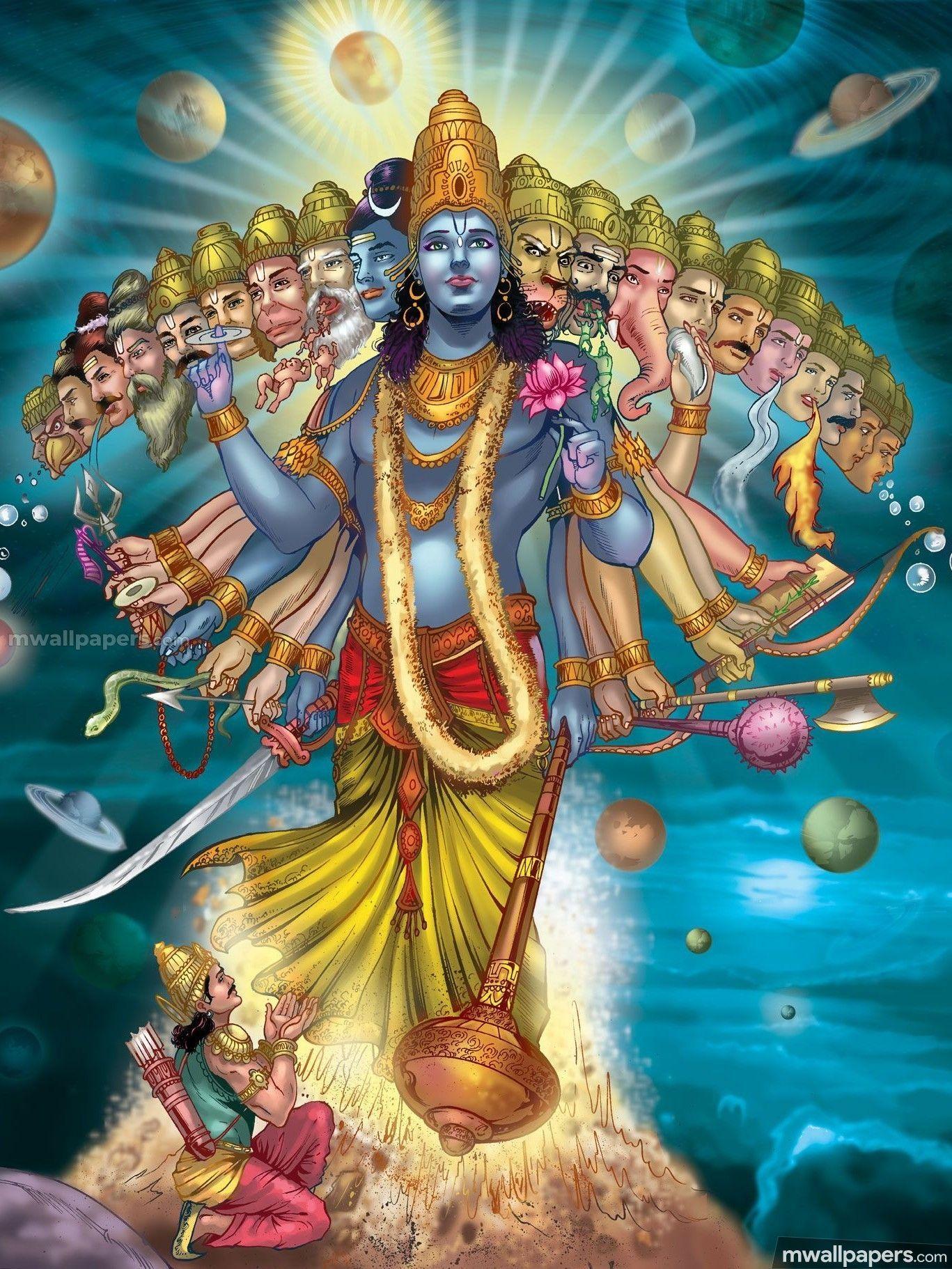
Top 10 Strongest Gods and Deities in The HIndu Mythology
Vishnu is said to descend in the form of an avatar to restore cosmic order. [1] The word Dashavatara derives from daśa, meaning "ten", and avatāra, roughly equivalent to "incarnation". The list of included avatars varies across sects and regions, particularly in respect to the inclusion of Balarama (brother of Krishna) or Gautama Buddha.
52 best Dashavatar images on Pinterest Lord vishnu, Avatar and Krishna
10 Avatars of Lord Vishnu 1. Matsya (Fish - Satya Yuga) 2. Kurma (Tortoise - Satya Yuga) 3. Varaha (Boar - Satya Yuga) 4. Narasimha (Half-man/half-lion - Satya Yuga) 5. Vamana (Dwarf - Treta Yuga) 6. Parashurama (Warrior with an Axe - Treta Yuga) 7. Rama (Prince/king of Ayodhya - Treta Yuga) 8. Balarama (Philosopher & Guide - Dwapara Yuga) 9.
The Complete 24 Avatars of Lord Vishnu Vedic Sources
Avatars [Incarnations or Descents] of Vishnu. [see also Narasimha; Puranas] Varaha, or the Boar Incarnation of Vishnu. Mahdya Pradesh, 9th-10th century. Sandstone. Height, 139.7 cm. Of the three gods that are constitutive of the Hindu trinity, Vishnu (the Preserver) alone has avatars or incarnations. His principal counterpart, Shiva (the.
What is the significance of the Varaha avatar of Vishnu? Quora
The significance of Varaha Avatar lies in his mission to rescue the goddess Earth, symbolized as Bhudevi, from the clutches of the demon Hiranyaksha. By assuming the form of Varaha, Vishnu defeats Hiranyaksha and restores balance to the universe. This avatar teaches us the importance of standing against injustice, protecting the weak, and.
The 10 Avatars of the Hindu God Vishnu
Dashavatara From Innumerable incarnations of Vishnu, Rishis or Sages selected ten Avatars as a representative of the rest; these ten incarnations are known in Sanskrit as "Dashavatar." The Dhashavatara list of Vishnu is introduced in Garuda Purana (1st millennium BCE). There are different versions of the Dashavatar list in different scriptures.
The Complete List of 24 Avatars of Lord Vishnu
Dashavatara, (Sanskrit: "Ten Incarnations") the 10 avatars of Vishnu, one of the principal deities in Hinduism. They represent the 10 times Vishnu descends to earth in order to restore cosmic order. Each of these incarnations has a particular mythology and is the object of devotion ( bhakti ).

Lord Vishnu Kurma Avatar Vishnu avataras, Vishnu mantra, Vishnu
4.5 4.5 out of 5 stars (based on 2 reviews) You may also like: Dashavatara: The Most Important Avatars of Lord Vishnu Samudra Manthan: One of the Most Beautiful Stories in Hindu Mythology Vishnu: The Powerful Protector of the World Table of Contents Vishnu Avatars First Avatar: Matsya avatar (The Fish) Second Avatar: Kurma avatar (The Tortoise)
10 Avatars of Vishnu (Dasavatara) Buddhism and Hinduism Wiki Fandom
1. Adi Purush Adi Purush is the first and the primary avatar of Lord Vishnu. Also known as Lord Narayana, he is depicted laying on the curls of a serpent, Adishesha. He is the source of all creation in the universe. The all-powerful; it is from his navel that the lotus sprouts where Brahma resides. 2. Four Kumars
The Ten Avatars Of Lord Vishnu Poster Zazzle.ca
The Dashavatara are the ten primary avatars of Vishnu. Out of these ten, Rama and Krishna are the most important. [16] Nomenclature Vishnu (or Viṣṇu, Sanskrit: विष्णु) means 'all pervasive' [17] and, according to Medhātith ( c. 1000 CE), 'one who is everything and inside everything'. [18]

Dasavatara Pictures 10 Incarnations Lord Vishnu
The incarnations that Vishnu takes are called avatars. The Hindu scriptures speak of ten avatars. They are thought to have been present in the Satya Yuga (the Golden Age or Age of Truth), when mankind was ruled by gods. Collectively, the avatars of Vishnu are called dasavatara (10 avatars). Each has a different form and purpose.
Tallapaka Annamacharya Keertanalu on Lord Vishnu Lord Vishnu Avatars
Dashavatar The 10 incarnations of Lord Vishnu are collectively known as the Dashavatar. These avatars often share Vishnu's blue skin color although they each have individual talents, personalities, and iconography. 1. Matsya, The Fish Matsya is Vishnu's first avatar. His legend is reminiscent of the tale about Noah's ark.
24 Avatars of Vishnu 24 incarnations of Lord Vishnu HinduPad
The 10 Avatars of Lord Vishnu (Dashavatara): Why Does Lord Vishnu Incarnate on Earth: 1. To protect Dharma in difficult times. 2. Because of the Curse of Sage Bhrigu. 3. To Kill the Despotic Asuras: 4. To Protect the Earth: Controversies Related to Dashavatara: Dashavatara Stotra: Dashavatara and Evolution: The Pattern of Dashavatara:

Vishnu by ch28 on DeviantArt Vishnu, God illustrations, Hinduism art
Narasimha avatar of Lord Vishnu is in the form of a part-man and part-lion who killed the despotic demon king Hiranyakashipu and restored dharma on the Earth. Hiranyakashipu's son Prahlada was a great devotee of Lord Vishnu. Therefore, he tried to kill him. Lord Vishnu appeared there from a pillar and killed Hiranyakashipu with his claws. 16.

Lord Vishnu Wallpapers Top Free Lord Vishnu Backgrounds WallpaperAccess
Varying lists of avatars of Vishnu appear in Hindu scriptures, including the ten Dashavatara of the Garuda Purana and the twenty-two avatars in the Bhagavata Purana, though the latter adds that the incarnations of Vishnu are innumerable. [10] The avatars of Vishnu are important in Vaishnavism theology.
Lord Vishnu and His Ten Avatars Levitating Monkey
Vishnu has the most avatars of any Hindu god or goddess. Each avatar represents an incarnation of Vishnu, sent to Earth by the god himself and charged with keeping the peace or battling some evil. Vishnu's avatars are the heroes of many of Hinduism's greatest legends and epics.

VISHNU ART — ☀ SHRI VISHNU NARAYANA ॐ ☀ “The manifest, the... Vishnu, Lord vishnu wallpapers
Dashavatara refers to the ten avatars of Vishnu, the Hindu god of preservation. The word Dashavatara derives from daśa, meaning 'ten' and avatar (avatāra), meaning 'descent'. Thus, Vishnu is said to descend in form of an avatar to restore cosmic order. These Avatars play a major role in shaping human evolution through centuries.